Early Views of Mt. Lowe Railway
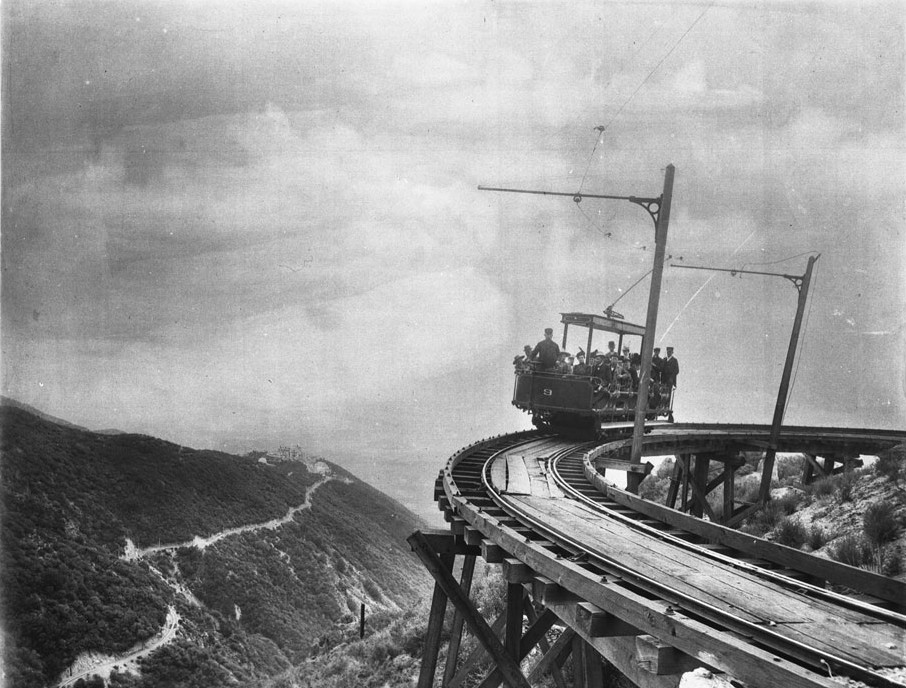 |
|
| (1893)* - Photograph of the first passengers of Professor S.C. Lowe's dramatic Mount Lowe Railway, July 4, 1893. There are a couple of dozen people in the rail car (number "9") which is headed toward the camera on the circular bridge. The trestle structure is visible below the rails. The hotel on the mountaintop is visible at left as is the rail approach to the hotel. |
Historical Notes At the turn of the century, one of Southern California’s most popular excursions was the Mount Lowe trip. Travelers boarded a Pasadena car from Los Angeles, transferring at Altadena to reach Rubio Canyon. From there, they ascended a 62% grade by cable car on the Great Incline to Echo Mountain, where they transferred again to a narrow-gauge trolley winding through the rugged San Gabriel Mountains to Alpine Tavern near the summit. The entire route stretched nearly seven miles from the canyon floor to the mountaintop. On clear days, visitors could see all the way to Catalina Island, more than sixty miles away. In 1892, Thaddeus Sobieski Coulincourt Lowe—known as Professor T. S. C. Lowe—founded the Mount Lowe project and railway. His partner, civil engineer David J. Macpherson, oversaw construction of the intricate mountain route, which was completed the following year. The mountain itself, originally named Oak Mountain, was renamed Mount Lowe in his honor. |
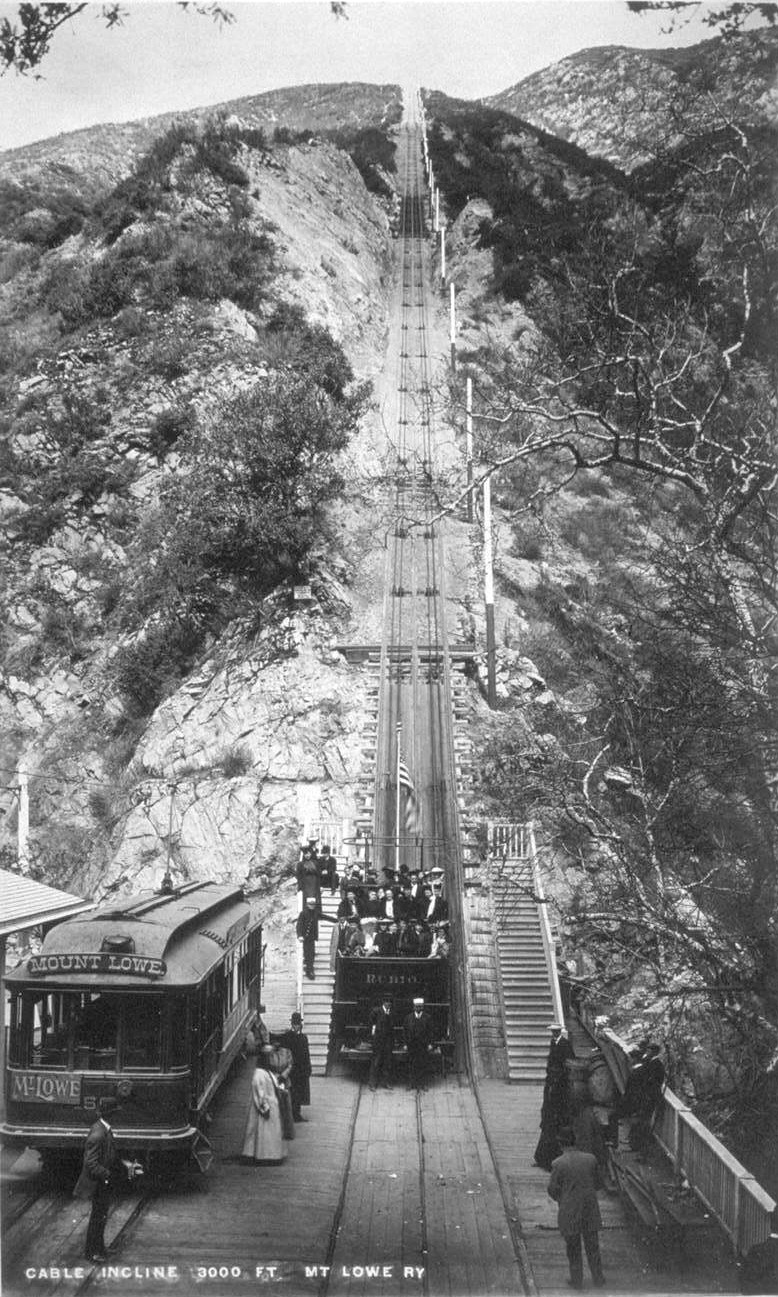 |
|
| (1893)* - The great Cable Incline (seen above) went from Rubio Pavilion (the bottom) to Echo Mountain (at the top). In this picture one of the cable cars, named "Rubio" sits at the bottom with some passengers aboard and others waiting nearby. Also on the left is the electric car which brought customers to the station from Mountain Junction. |
Historical Notes The Great Incline’s cable system was engineered by Andrew Smith Hallidie, the same man who designed San Francisco’s famous cable car network. The Mount Lowe Incline rose 2,200 feet in elevation using roughly 6,000 feet of spliced steel cable running in a continuous loop to raise and lower the two counterbalanced cars. It was a marvel of precision engineering and one of the steepest funiculars ever built in the United States. |
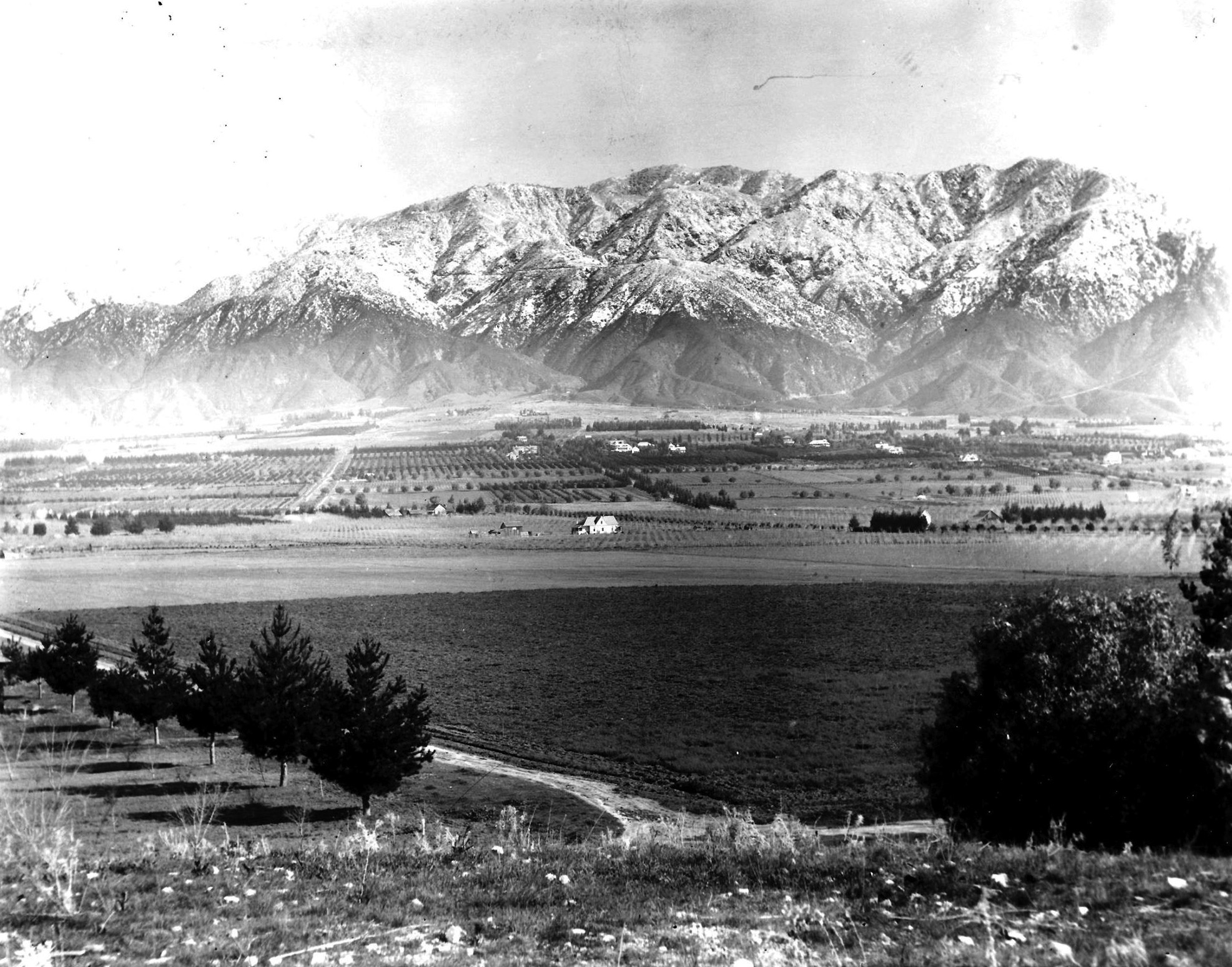 |
|
| (1897)* - Winter view looking northeast from Monk's Hill showing the San Gabriel Mountains covered with a blanket of snow. You can just make out Mount Lowe Rwy. entering Rubio Cyn. and Alpine Division ascending from Echo Mountain. The dirt intersection in foreground is of Howard and Marengo. Photo courtesy of Paul Ayers |
Historical Notes By the late 1890s, the Mount Lowe Railway had become a symbol of Pasadena’s prosperity and a favorite destination for both locals and tourists. The railway’s bright red cars were a familiar sight winding through the canyons, and the mountain resorts above offered winter scenery rarely seen so close to the Southern California coast. |
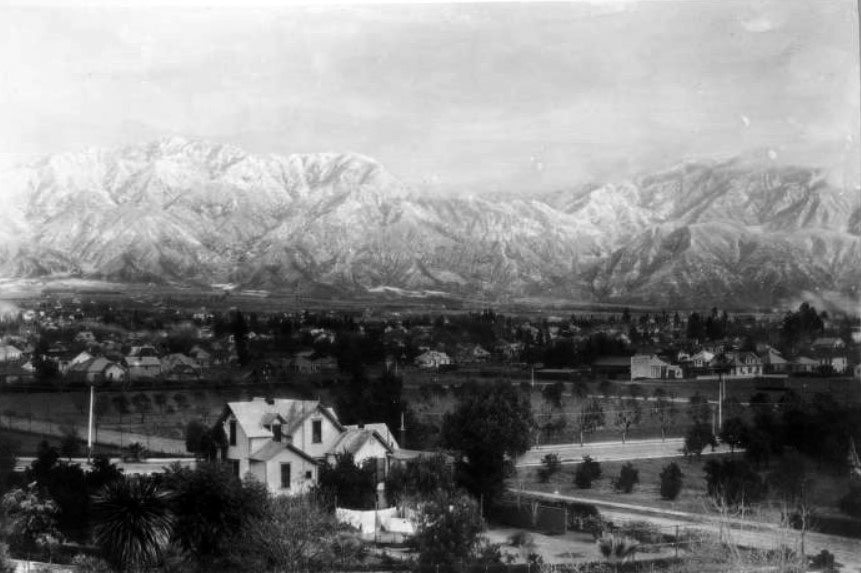 |
|
| (ca. 1900)* - Panoramic view of Echo Mt. and Mt. Lowe from Pasadena with snow on the mountains and houses and orange groves visible in the foreground. |
Historical Notes Long before the railway was built, Pasadenans dreamed of a scenic mountain route to the crest of the San Gabriels. Civil engineer David J. Macpherson, a Cornell University graduate, developed the first viable plans for such a line. When he met Professor Lowe, who had both the vision and financial resources to make it possible, their partnership transformed the dream into reality. |
 |
|
| (Early 1900s)* - Panoramic drawing by W. H. Bull of Pasadena and Altadena and the majestic San Gabriel Mountains in the background. The drawing depicts the Mt. Lowe Railway with its Cable Incline rail, Circular Bridge, "Ye Alpine Tavern", and Echo Mountain House and Station as it appeared in the early 1900s. |
Historical Notes In 1891, Lowe and Macpherson incorporated the Pasadena & Mount Wilson Railroad—later renamed the Mount Lowe Railway. After being denied right-of-way access to Mount Wilson, they redirected the route toward Oak Mountain via Echo Canyon. What made the Mount Lowe Railway unique was that it operated entirely on electric power—an all-electric traction system unprecedented for mountain travel at the time. Andrew McNally, the co-founder of Rand McNally, later helped make the name “Mount Lowe” official by printing it on his maps after moving to Altadena. |
 |
|
| Diagram showing the three connected segments of the Mount Lowe Railway: the electric trolley to Rubio Canyon, the Incline Railway to Echo Mountain, and the mountain trolley to Alpine Tavern near the summit.* |
Historical Notes During its 45 years of operation, an estimated three million passengers rode the Mount Lowe Railway. The trip was considered a “must-see” attraction for visitors from around the world—an early form of what might today be called adventure tourism. Daily publications from the Alpine Tavern, such as The Echo, listed the names and home states of arriving guests alongside announcements and stories about mountain life. In many ways, Mount Lowe was a precursor to the theme park experience—a true “Disneyland of its day.” |
* * * * * |
Construction of the Great Incline
 |
|
| (ca. 1892)* – View showing the construction of the bridge at the foot of the Great Incline. Courtesy of Mt. Lowe Preservation Society |
Historical Notes Construction of the Great Incline began in December 1891 under the direction of Professor Thaddeus S. C. Lowe and chief engineer David J. Macpherson. The project proved to be one of the most ambitious civil engineering efforts of its day. Workers had to blast their way through the rugged walls of Rubio Canyon, where loose granite and narrow ridges made progress slow and dangerous. By September 1892, the first section of the railway reached the mouth of the canyon, but the final mile to the Incline platform was the hardest. It required nine timber bridges and heavy excavation before the track could begin its dramatic rise toward Echo Mountain. Despite months of setbacks, the men pressed on with picks, shovels, and sheer determination — building by hand what would soon become one of the steepest funicular railways in the world. |
 |
|
| (1892)* - Construction begins on the Great Incline of the Mount Lowe Railway in Rubio Canyon. Photo courtesy of Paul Ayers. |
Historical Notes The early stages of construction were grueling. Just above the lower station, a rocky ridge known as Granite Gorge cut across the planned route. To reach the canyon beyond, crews had to carve a grade through solid rock without the benefit of modern machinery. The terrain was so steep that mules refused to climb it, forcing laborers to carry rails, timbers, and tools on their backs. It took eight long months to complete the cut through Granite Gorge — a stretch of only a few hundred feet but one that tested the endurance of every worker involved. |
 |
|
| (ca. 1892)* - Workers completing the Incline Track about three-quarters of the way up to Echo Mountain. Photo courtesy of Paul Ayers. |
Historical Notes As the work progressed, the challenges increased. Grading was done by hand, and every cubic yard of material had to be hauled away or relocated manually. Workers couldn’t dump debris downhill, as it would have filled the canyon and buried the future loading platform. Instead, gangs of men carried the rubble up the slope roughly 50 yards before dumping it into a side ravine. When the first rails were finally laid, the sense of achievement was immense. The Incline’s 62% grade was among the steepest ever attempted, and its completion marked a turning point in the Mount Lowe project. What had once seemed impossible now stood as a triumph of persistence and ingenuity — a structure that would carry sightseers to the clouds for decades to come. |
 |
|
| (ca. 1892)* – View showing to top of Echo Mountain during grading and construction. In the distance can be seen the construction tent and to the right can be seen the cut from which the Alpine Division will eventually make its way toward the photographer. Courtesy of Mt. Lowe Preservation Society |
Historical Notes Prior to the opening of the incline on July 4, 1893, quite a bit of grading and preparation had to be done to Echo Mountain. The pack burros in the foreground hauled everything up the hill including barrels of water, nails, and lumber until a windlass could be installed to drag things up the rough cut of where the incline would be installed. |
* * * * * |
Opening Day
 |
|
| (1893)* - View showing the first Mount Lowe Railway car to leave Altadena from Mountain Junction, the corner of Lake Avenue and Calaveras Street, for Rubio Canyon, July 4, 1893. A large group of finely-dressed people gather on the railroad platform looking towards the foreground. Many stand on the raised, wooden platform at right while others sit on a decorated railroad car at center. Two small boys stand on broken shards of wood in the foreground while flags wave in the background. USC Image Archive |
Historical Notes The Mount Lowe Railway officially opened on July 4, 1893, marking a milestone in Southern California’s transportation and tourism history. Until that day, the only public link from the valleys below to the hillside community of Altadena was the Los Angeles Terminal Railway, which ran from Terminal Island in San Pedro to Mountain Junction. The Mt. Lowe line changed everything—making the mountains accessible to ordinary people seeking recreation and cool air. Trains initially ran only twice a day, but service expanded dramatically after Henry E. Huntington and the Pacific Electric Railway acquired the line in 1902, integrating it into the “Red Car” system. |
 |
|
| (Early 1900s)* – Pacific Electric Railway timetable showing travel times from Los Angeles to Mount Lowe, with stops in Pasadena, Altadena, Hyglea, Rubio Canyon, Echo Mountain, and Mount Lowe. Visitors could leave Los Angeles at 8:00 a.m. and reach the mountaintop by 10:00 a.m. |
Historical Notes The timetable illustrates how well-integrated the Pacific Electric system became by the early 1900s. The two-hour trip from downtown Los Angeles to Mount Lowe offered a unique escape—an affordable, scenic mountain adventure for residents and tourists alike. Passengers could enjoy breakfast in Los Angeles and lunch amid the cool mountain air, a remarkable convenience for the time. |
* * * * * |
Getting There: Transportation to Rubio Canyon
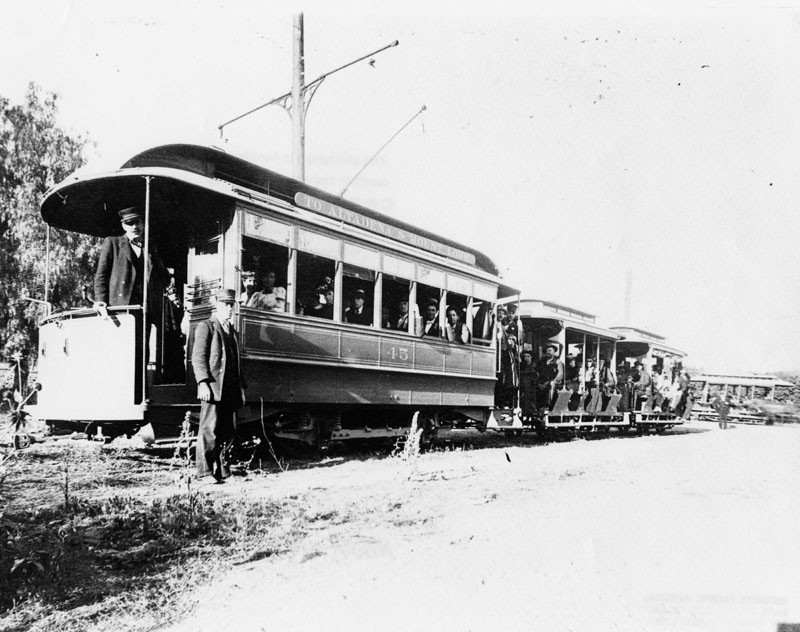 |
|
| (ca. 1896)* - View of three Pacific Electric streetcars filled with travelers on their way to Altadena, with continuing service to Mount Lowe. The lead car, No. 45, displays “Mount Lowe” on its destination sign. This photograph was taken at Lake Avenue and Mariposa Street in Altadena. |
Historical Notes Visiting Mount Lowe quickly became one of Southern California’s most popular excursions. The trip began at Mountain Junction, where passengers boarded electric trolleys bound for Rubio Canyon. From there, they transferred to the Great Incline cable railway for the steep ascent to Echo Mountain. The combination of electric trolleys, cable cars, and mountain switchbacks made the experience both thrilling and memorable. |
 |
|
| (Early 1900s)* - Passengers departing from the Rubio Pavilion for their return trip to Altadena after spending a day or more up in Mount Lowe. The pavilion, seen at right, marked the transfer point between the narrow-gauge electric trolley and the “Great Incline” cable railway, visible at left. |
Historical Notes The Rubio Pavilion served as the gateway to Mount Lowe. Visitors arriving here could rest, dine, or explore the nearby waterfalls before continuing up the mountain. The pavilion was both a depot and a small resort, offering a comfortable transition between the urban electric cars and the rugged incline railway. |
 |
|
| (ca. 1910)* – Pacific Electric Railway car No. 151 at Rubio Canyon, waiting below the Great Cable Incline. The incline car has just departed for Echo Mountain while Car 151 prepares to take passengers back to Los Angeles. |
Historical Notes This image captures the end of a journey that had taken riders from the city streets to the very edge of the wilderness. After descending from Echo Mountain, travelers would board one of the Pacific Electric’s cars, such as No. 151, for the trip back to Los Angeles. The entire round-trip excursion offered one of the most dramatic scenic experiences of the early 20th century. |
* * * * * |
Rubio Canyon and the Pavilion
 |
|
| (ca. 1900)* - View showing the Rubio Hotel which appears to be built on stilts at the edge of the canyon. |
Historical Notes At the Rubio terminus, a broad platform extended across the canyon and supported the Rubio Pavilion—a 12-room hotel offering dining and overnight accommodations. The site also contained the railway’s power plant, which used Pelton waterwheels driven by canyon streams to generate electricity. Because the water supply was seasonal, maintaining consistent power and comfort posed a constant challenge. |
 |
|
| (Early 1900s)*- View showing the Mount Lowe Railway tracks passing by the Rubio Hotel, completed in 1894. A support structure was later added beneath the building to stabilize it along the steep canyon wall. |
Historical Notes The hotel quickly became a popular stop for tourists seeking to enjoy the canyon’s natural beauty before riding the Incline. Over the years, additional bracing and supports were added to keep the structure secure against rockslides and flash floods that frequently swept through the canyon. |
 |
|
| (1890)* - Rubio stairs just below Suspended Boulder in Rubion Canyon. Photo courtesy of Paul Ayers |
Historical Notes The Mount Lowe Railway company constructed a network of stairways and walkways to give visitors safe access to the canyon’s waterfalls and scenic viewpoints. The sign in the lower right warns guests not to climb the fragile canyon walls—a reminder of the steep, rugged terrain that surrounded them. |
 |
|
| (ca. 1900)* - Postcard view showing Rubio Canyon’s waterfalls near the foot of the incline. Moss Grotto is above with Ribbon Rock Falls below. |
Historical Notes Professor Lowe enhanced the natural charm of Rubio Canyon by building stairways, bridges, and viewing platforms that allowed visitors to explore its eleven waterfalls, each individually named. These cascades, with names like Moss Grotto and Ribbon Rock Falls, became highlights of the excursion and remain known landmarks among local hikers today. |
* * * * * |
The Great Cable Incline: Gateway to Echo Mountain
 |
|
| The plan for a three-railed incline devised by Prof. Lowe.* |
Historical Notes While funiculars generally required four rails (two each for the ascending and descending cars), the narrow canyon slope made that impossible. Thaddeus Lowe solved the problem by designing a three-rail system that used a shared center rail for most of the route, with a fourth rail added only at the midpoint where the cars passed. This clever design reduced costs and made construction feasible on the steep terrain. It later inspired similar systems, including Angels Flight in downtown Los Angeles. The Great Cable Incline became one of the earliest mountain funiculars in the United States to adopt this method, operating on a continuous cable loop in which the rising car counterbalanced the descending one. |
* * * * * |
Rubio Pavilion and the Base of the Incline
 |
|
| (1893)* - Rubio Pavilion and base of the Great Incline, Mt. Lowe Rwy. |
Historical Notes Rubio Pavilion served as the lower terminus for the incline line. It included a hotel, waiting rooms, dining areas, and essential utilities for visitors and staff. It was also the transfer point from the Altadena streetcar line to the incline. The pavilion, bridges, and stair systems enhanced the visitor experience by connecting the canyon’s waterfalls and trails. |
 |
|
| (ca. 1893)* - A group poses in the car at the bottom of the Great Incline below Echo Mountain. In the upper left corner of the group is Professor T.S.C. Lowe, the founder of the Mount Lowe project and the Mount Lowe Railway. |
Historical Notes This photograph shows Lowe himself at the base, underscoring his leadership. The car is one of the opera-box style cars, later known as “White Chariots,” painted white to be visible from afar. Visitors gathered in formal dress to ride the incline as part of the spectacle. |
 |
|
| (1890s)* – Colorized image showing a car full of passengers as it begins its ascent up the Great Cable Incline. Photo courtesy of John Steven Fode. |
Historical Notes This colorized image captures the moment of departure — passengers climbing into the steep angle. At the lower third of the incline, the gradient reached up to 60–62 %. Materials for the incline were hauled by hand, pack mules, or burros before full track was laid. This vivid image captures the color and excitement of the early railway experience, bringing new life to one of Southern California’s most daring engineering feats. |
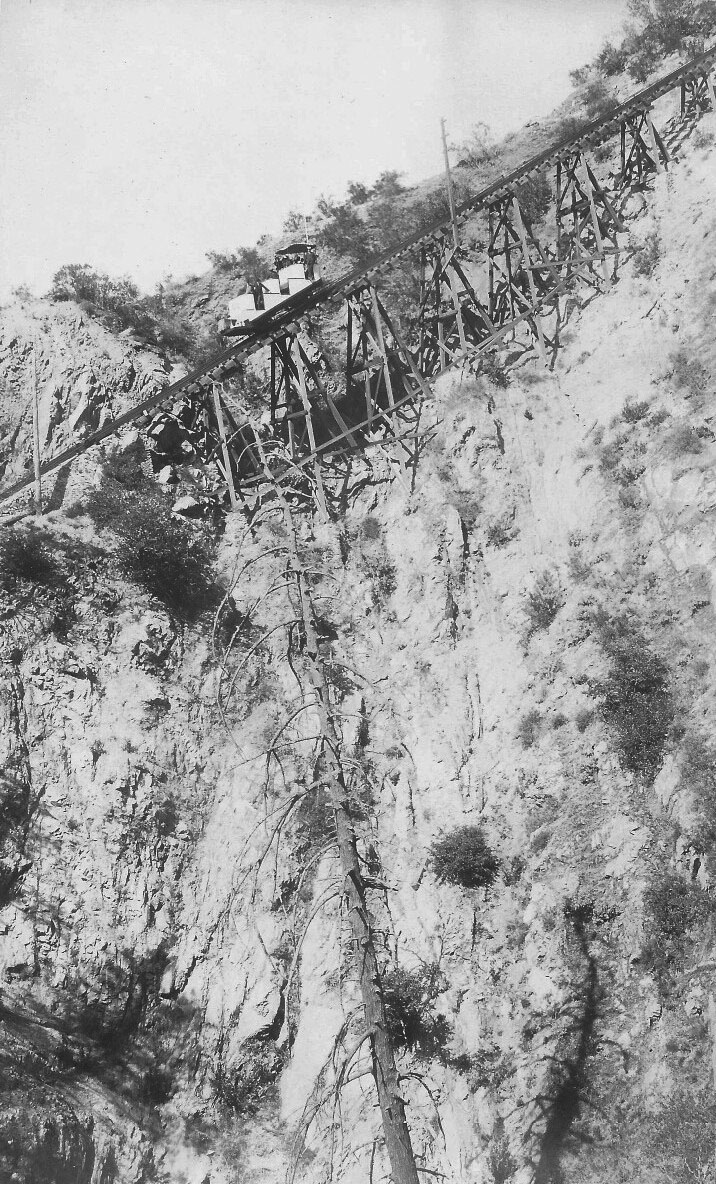 |
|
| (1890s)* - Profile view of Mount Lowe's Cable Incline showing its steep 62% grade. |
Historical Notes The incline grade was not uniform: it began around 60 % at the bottom, peaked near 62 % in steeper sections, and eased toward the top to about 48 %. Each car had a safety cable and an under-car braking mechanism; if the main cable failed, the system could stop a car within about 15 feet. |
* * * * * |
The Journey Upward: Innovation Meets Experience
 |
|
| (1906)* – View looking down the Great Incline showing how the three-rail tracks widen to four at the center of the line, enabling the cars to pass each other. Note workmen on the right side of track |
Historical Notes At the midpoint of the incline, the track widened to four rails, allowing the ascending and descending cars to pass safely before merging back to three. Elsewhere they shared the middle rail. The presence of workmen in the image reinforces how maintenance was constant on such a steep and demanding line. |
 |
|
| (1893)* - View of Mount Lowe's cable incline. A group poses in the car at the bottom of the incline and in front of the Mount Lowe trolley. |
Historical Notes This early view shows the connection between the trolley line (from Altadena) and the incline. Visitors would transfer from the trolley to the incline at Rubio Pavilion. The contrast between the two modes of transit emphasizes how ambitious the full ascent was. |
 |
|
| (ca. 1894)* - View of Mount Lowe's incline railway. A group poses in the car at the bottom of the incline. Note that the newly constructed Echo Mountain House now appears at the top of the hill. |
Historical Notes By late 1894, the grand Echo Mountain House stood atop the incline. This image demonstrates how the hotel expanded the allure of the climb. The resort buildings, the observatory, and supportive structures were all painted white — giving rise to the name “White City in the Sky.” |
* * * * * |
Arrival at Echo Mountain
 |
|
| (1900)* - Passengers arriving at the top of Echo Mountain on one of the Incline cable cars. Photo from the Ernest Marquez Collection. |
Historical Notes Arrival at the top was a celebrated moment. Official photographers often stood on platforms to capture groups disembarking. Many visitors purchased souvenir images from those photographers. The journey was smooth but thrilling — the cars climbed more than 1,300 feet in elevation while offering panoramic views of Rubio Canyon below. |
 |
|
| (ca. 1890s)* - View showing a group of visitors posing in one of the earlier Incline cable cars. |
Historical Notes These “opera-box” cars could seat up to around 30–60 persons, with leveling seats as the grade shifted. The dual car system was counterbalanced: as one rose, the other descended, using the same cable loop. |
 |
|
| (ca. 1895)* - View showing a group of visitors arriving at the top of Echo Mountain on one of the Incline cable cars. Another group appears to be waiting for the next ride down. The Echo Mountain House is seen at left perched on top of the hill at approximately 3,500 feet. |
Historical Notes By this time, the summit had become a hub of activity. The original Echo Chalet and later the larger Echo Mountain House served guests. In 1900, a kitchen fire destroyed the main hotel. The facility was never fully rebuilt, and subsequent fires and storms further weakened the resort’s viability. |
* * * * * |
Life at the Summit
 |
|
| (1890s)* - View showing the Incline Cable car as it passes the Echo Mountain House perched on the top of the hill. |
Historical Notes This image captures the moment when the incline car is next to summit buildings, symbolizing the connection between transportation and hospitality. Echo Mountain was developed with trails, observation decks, gardens, and gathering spaces designed for rest and recreation. |
 |
|
| (1898)* - Cable car running up the Mt. Lowe Incline. Photo courtesy of Altadena Historical Society. |
Historical Notes By 1898, the incline was in full operation. During its history, Lowe lost control of the railway around 1899. In 1902, Henry E. Huntington and the Pacific Electric Railway acquired it, marking a shift in management. |
 |
|
| (ca. 1900)* - Postcard view of Incline car, Mt. Lowe Rwy., looking southwest. Photo courtesy of Paul Ayers. |
Historical Notes Postcards were a primary medium for promoting Mount Lowe to distant audiences. The incline line, with expansive views of San Gabriel Valley and beyond, was marketed as a scenic adventure. |
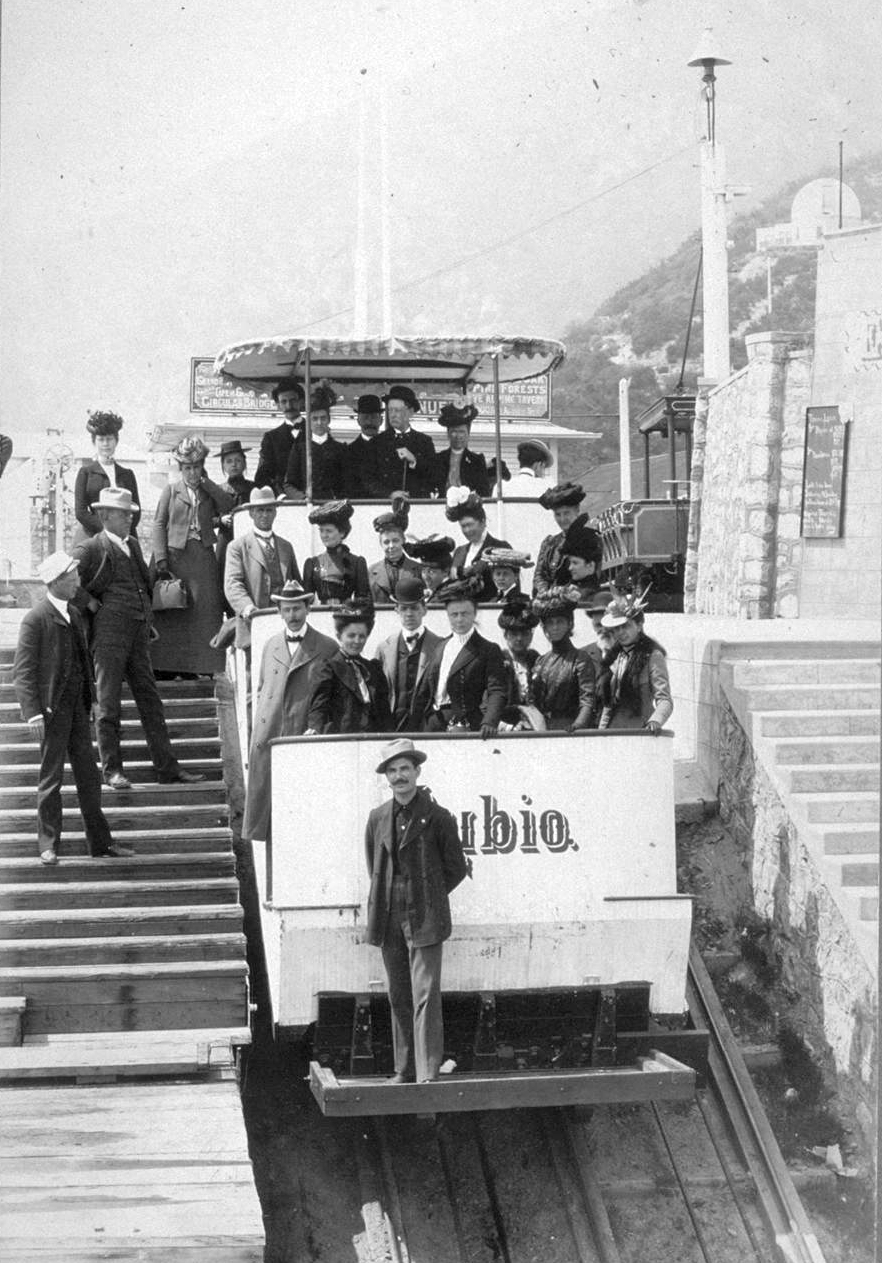 |
|
| (ca. 1900)* - Visitors to Echo Mountain pose on one of the Incline opera-box cable cars (called 'White Chariots') which transports them on the Mount Lowe Railway. The car moved between Rubio Pavilion at the bottom of the incline to Echo Mountain at the top. |
Historical Notes “White Chariots” was a signature branding of the incline cars — elegant, visible, and part of the experience. At the summit, guests explored the observatory, gardens, and walking paths. |
* * * * * |
Echo Mountain in Retrospect
 |
|
| (Early 1900s)* - Souvenir photo showing a group of visitors posing for the photographer at the top of the incline. Background sign reads: “Pacific Electric Ry Co. – Ye Alpine Tavern 5,000 Ft. Above Sea Level – Mt. Lowe 6,100 Ft. – Echo Mountain 3,500 Ft.” Photo courtesy of David S. Brown. |
Historical Notes By this period, the Pacific Electric Railway had taken control of the line. The elaborate signage, taverns, and resort atmosphere were used to attract tourists over long distances. The summit became less a transit point and more a destination in itself. The backside of the Mt. Lowe Historical and Descriptive Souvenir Photo reads: The Mt. Lowe Division of the Pacific Electric Railway, for safety, speed and comfort, is foremost amongst the scenic mountain railways of the world, offering to the pleasure seeker an ideal trip for sight-seeing and recreation surpassed by none. Originated and built by Prof. T. S. C. Lowe and opened to the public July 4th, 1893, on which date the first White Chariot ascended the great Cable Incline, 3,000 feet in length over a maximum grade of 62 percent and a direct ascent of 1,325 feet to Echo Mountain, an altiitude of 3,500 feet. Here the incline machinery is located and open to the inspection of the public. Here also is located the 3,000,000 candle power searchlight and the Great Lowe Observatory. The safety appliances, among which may be mentioned the great tensile strength of the pulling cable, tested to a strain of 100 tons, whereas the actual load never exceeds five tons. The secondary, or safety cable with its automatic devices, the speed indicator and automatic brakes, combined with extreme operative care, provide that security of travel attested by the fact that no accident has ever marred the history of its operation. From Echo Mountain extending five miles through the Sierra Madre mountains the trolley winds its way up Mt. Lowe to Alpine Tavern. The line, a marvel of engineering and creative skill, entailing the construction of 20 bridges and 127 curves, winding its way to Alpine Tavern 1,100 feet below the summit of Mt. Lowe. The Tavern is open every day of the year and first-class meals are furnished at reasonable rates, also good comfortable accomodations by the day or week. Here one can rest in the quietness of the surroundings or find enjoyment in feeding the friendly birds and squirrels of the forest or ascend the summit on horse-back and from an altitude of 6,100 feet view mountains, valley and sea, an inspiring sight indeed. Pacific Electric Ry Co. owned and operated the Mt. Lowe railroad system from 1902 until it closed in 1938. Click HERE to read more. |
 |
|
| (ca. 1905)* – View looking down the Mt. Lowe Incline. Note the photographer's boots in the lower corners of the image. |
Historical Notes This striking downward view emphasizes the drama and steepness of the incline. By 1905, fires and storms were already threatening infrastructure; the Echo Mountain House had burned, and recovery was never complete. |
 |
|
| (n.d.)* - Panoramic view of Mount Lowe showing the Great Cable Incline (left), Echo Mountain House at the top, and winding trails to the right. |
Historical Notes This wide-angle view situates the incline route, summit buildings, and the web of pathways. It reminds viewers of how much terrain the railway overcame to reach the mountain. |
 |
|
| (ca. 1920s)* - Passengers pose for the camera on the Mount Lowe Railway incline car to Echo Mountain. A sign above reads “Echo Mountain 3500 feet above sea level,” and the car front says “Echo.” A Pacific Electric streetcar is also visible at right. In the distance is the domed observatory. (Huntington Library) |
Historical Notes By the 1920s, the incline continued operating under Pacific Electric management, though storms and declining ridership signaled its final years. The observatory remained a visual symbol of the mountain’s scientific ambition. The line was finally abandoned in December 1937, and a destructive flood in March 1938 sealed its fate. |
* * * * * |
Echo Mountain
 |
|
| (1890s)* - Side view of Echo Mountain House as seen from the from Mount Lowe Ry. |
Historical Notes Atop Echo Mt. stood the magnificent 70-room Victorian hotel, the Echo Mountain House. Only a few hundred feet away stood the 40-room Echo Chalet which was ready for opening day. The complement of buildings on Echo included an astronomical observatory, car barns, dormitories and repair facilities, a casino and dance hall, and a menagerie of local fauna. Passengers could then transfer to another trolley line, the Alpine Division, which would take them to the upper terminus at Crystal Springs and Ye Alpine Tavern, a 22-room Swiss Chalet hospice with a complement of amenities from tennis courts, to wading pools, to mule rides. |
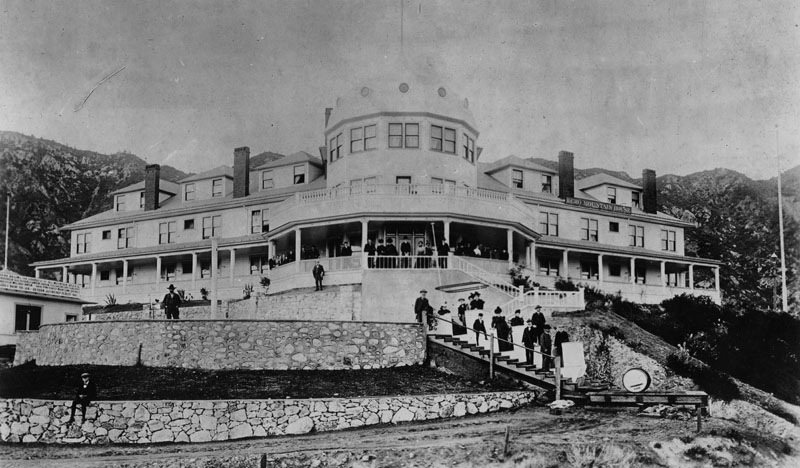 |
|
| (1890s)* - View of some of the hotel guest standing on the veranda and stairways at the front of Echo Mountain House. |
Historical Notes Completed in the fall of 1894, the Echo Mountain House was a marvel. The four-story Victorian building was marked by a tall, cylindrical tower and capped by a metal dome and a huge American flag. The bright white exterior was marked by a long row of windows on each floor. At the building’s entrance, two sweeping verandas looked off across the canyons and the valley. |
 |
|
| (1890s)* - People standing on balcony of Echo Mountain House looking at the panoramic view of Pasadena. Huntington Library |
 |
|
| (ca. 1898)* – View showing the interior of Echo Mt. House. Dr. Lewis Swift, the original resident astronomer of the Mt. Lowe Observatory is seated in rocking chair with the dining room seen in the rear. Photo courtesy of Paul Ayers |
Historical Notes The interior of the hotel was extravagant, with detailed wood inlay, the finest floral-patterned carpet and handmade furniture throughout. There were seventy guest rooms, large areas for office space, a massive social hall and dining room, a souvenir shop, a Western Union office, a bowling alley, a billiard room, a barbershop and a shoeshine stand. |
 |
|
| (1890s)* - Another exterior view of Echo Mountain House with its 70 guest rooms. |
Historical Notes Echo Mountain House was built in 1894 and burned down in a fire in 1900. |
 |
|
| (1895)* - Exterior view of Echo Mountain House looking east from a zoo building that sits just below the tracks. Two men look through the bars of the zoo exhibit. |
Historical Notes The zoo structure consisted of cages where squirrels, bobcats, hawks, owls, foxes, and even a bear could be found. |
* * * * * |
Echo Phone
 |
|
| (ca. 1930s)* – View showing a woman yelling into the Echo Phone on top of Echo Mountain. Courtesy of Mt. Lowe Preservation Society |
Historical Notes The Echo Phone was used by visitors to project their voice from behind the Echo Mountain House on the Mount Lowe Railway. It still exists today. |
 |
|
| (2022)* - Contemporary view of a refurbished Echo Phone on top of Echo Mountain. Sign reads: "Echo Mountain was so named because of the many echoes that can be hear across Rubio Canyon." Photo by Stephen Nu. |
Historical Notes The Echo Phone is a ground-mounted, megaphone-like device located on Echo Mountain that lets hikers experience a unique and playful echo effect. When you shout into it, your voice bounces across Rubio Canyon and returns a few seconds later, creating a fun and memorable moment on the trail. This device is a relic from Echo Mountain’s past as a popular tourist destination in the late 19th and early 20th centuries. One of the main attractions was the Echo Mountain House, an 80-room hotel built in 1894 as part of the "White City" resort developed by Professor Thaddeus S.C. Lowe. The Echo Phone was one of several amusements for guests, amplifying the natural echoes that gave the mountain its name. There was once a second Echo Phone at nearby Inspiration Point, allowing visitors to shout back and forth between the two spots. Today, the Echo Phone remains as both a quirky piece of history and an entertaining reward for hikers who make the climb. |
Then and Now
 |
|
| (1930s vs 2022) - The Echo Mountain 'Echo Phone'. Contemporary photo by Stephen Nu. |
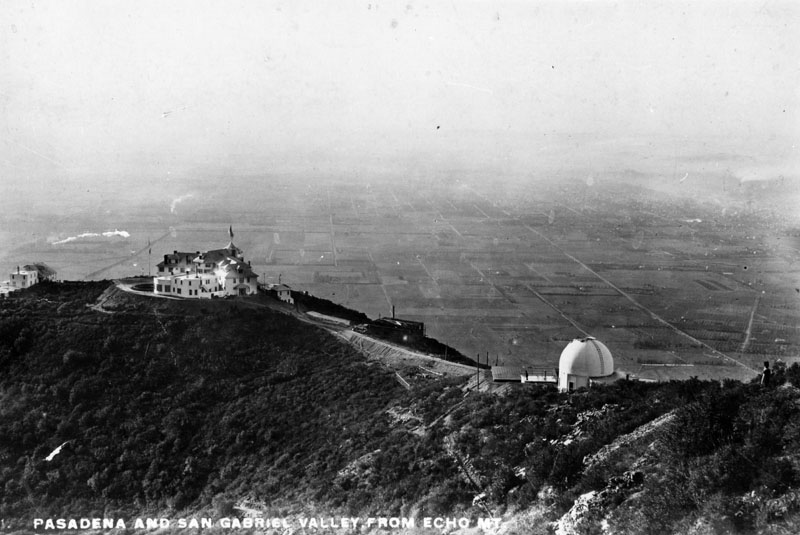 |
|
| (ca. 1890s)* - View of Pasadena and San Gabriel Valley from Echo Mountain. |
Historical Notes Buildings at Echo Mountain, reached by the Mount Lowe Railway, included the Echo Mountain House, a 70-room hotel at an elevation of approximately 3500 ft., the 40-room Echo Chalet, the observatory, car barns, dormitories, repair facilities, and a casino/dance hall. A kitchen fire destroyed the Echo Mountain House in 1900. The observatory was commissioned by Thaddeus Lowe in 1893 and continued in operation until 1928 when a storm damaged the dome.* |
.jpg) |
|
| (ca. 1890s)^*^ - Panoramic view showing Echo Mountain with the San Gabriel Valley in the background on a crystal clear day. |
 |
|
| (ca. 1890s)* - Panoramic view of Mount Lowe Observatory and Echo Mountain House and other structures, all painted white. |
Historical Notes All of the buildings on the mountain, including the Chateau, were painted the same brilliant white. “The White City,” as it was called, included the Echo Mountain House, a dance hall, a petting zoo, a post office, tennis courts and, to Lowe’s scientific delight, an observatory. |
 |
|
| (ca. 1896)*^ - The Echo Mountain Promotory after a snowfall, and the White City resort of the Mount Lowe Railway as seen from a higher spot on the ridge and overlooking Altadena, CA. Buildings viewed from left to right: The Echo Chalet, Echo Mountain House, Incline Powerhouse, Dormitories and Car Barn. Behind the car barn, note an inflatable reservoir for the storage of hydrogen gas produced in Pasadena and piped some 8½ miles to Echo. |
Historical Notes Prof. Lowe’s success was greatly drawn from his nationally renowned process of generating large amounts of hydrogen gas. He had built a gas plant in Pasadena and had piped the gas some eight miles to the top of Echo Mt. where there was a storage container seen in the above photo. The technology, mainly used for heating and lighting, was soon replaced by electricity. Click HERE to see Prof. Lowe's Biography. |
 |
|
| (1922)* - Panoramic view of Pasadena and surrounding areas, as seen from top of Echo Mountain. View also shows, Mount Lowe Observatory in the foreground. Catalina Island (over 60 miles away) can be seen in the far background. Click HERE to see more in Early Views of Catalina. |
 |
|
| (n.d.)* - Exterior view of Mount Lowe Observatory. View also shows snow-covered mountains in the background. |
Historical Notes Prof. Lowe installed a 16-inch telescope and observatory on Echo, as he was a patron of the astronomical arts. He even sought to have the Mount Lowe Railway considered the astronomical center of the San Gabriels. He was even able to enlist astronomer Dr. Lewis Swift, whose reputation preceded him. |
 |
|
| (1897)* - View of the Mt. Lowe Observatory with visitors posing in front of it. The original resident astronomer, Dr. Lewis Swift, is seen standing in the observatory doorway. Photo courtesy of Paul Ayers |
Historical Notes Lewis A. Swift was a world-renown famous astronomer who discovered a number of comets over his lifetime. Lowe invited Swift and his astronomical equipment to be the head of the new Mount Lowe Observatory. Lowe wanted the best of everything – and having Swift on top of Echo Mountain was considered by Southern Californians as quite a coup. Swift would give evening lectures open to the ticket buying visitors and he would bring and use his 16 inch refractor telescope was used in many of his past discoveries. Given the heavens not yet being disturbed by city lights, Swift was able to discover some 95 new nebulae from the Echo vantage point. |
 |
|
| (n.d.)* - Professor Edgar Lucien Larkin poses with the Mount Lowe telescope, which was located on the mountain above Altadena |
Historical Notes After astronomer Dr. Swift’s eyesight began failing him, ca. 1900, a second astronomer was hired to oversee the observatory, Prof. Edgar Lucien Larkin (1847–1925). Though he was not as prominent as Prof. Swift, he did stay with the Mount Lowe Observatory until his sudden death in 1925. |
 |
|
| (n.d.)* - Panoramic view of Altadena as seen from above Lowe Observatory from the Mount Lowe Railway. |
 |
|
| (1922)* - Panoramic night view of Pasadena and surrounding areas in the Valley, as seen from Mount Lowe. |
* * * * * |
The Great Incline - 1920s
 |
|
| (1920s)* – View showing a wood-bodied Pacific Electric Railway “Mount Lowe” car sitting at the platform at Rubio Canyon while passengers line up for their trip up the incline. Beyond the head of the line is the waiting room and restrooms, and at some point in time there was a gift and snack counter. Photo courtesy of the Mt. Lowe Preservation Society. |
Historical Notes In the 1920s, the Mount Lowe Railway was operated by the Pacific Electric Railway, which had acquired and improved the scenic mountain line after 1902. Visitors typically traveled from Los Angeles or Pasadena on Pacific Electric “Red Cars” to Altadena, then transferred to electric trolleys that climbed to Rubio Canyon. From there, passengers boarded the famous cable car funicular to ascend the steep incline to Echo Mountain, where they could enjoy amenities such as hotels, an observatory, and entertainment venues. Continuing their journey, travelers transferred to another electric trolley for the winding ride to the Alpine Tavern, navigating sharp curves and bridges along the mountain route. During this period, Pacific Electric upgraded the line with more robust double-truck cars designed for mountain service, improved power supply, and expanded facilities at the Alpine Tavern. Despite repeated natural disasters and the growing popularity of automobiles, the railway remained a major Southern California tourist attraction throughout the decade, offering daily scheduled service and carrying thousands of visitors each year. |
.jpg) |
|
| (1900s)* - Tourist snapshot looking from the Mount Lowe incline car over the trestle and over the top of a wood bodied streetcar and down through a hazy Rubio Canyon. Note how steep the incline is. Courtesy of Mt. Lowe Preservation Society |
 |
|
| (n.d.)* - View looking up to the top of the Great Incline with a sign at the base reading: “Direct Ascent 1245 Feet - Length of Incline 3000 Feet - Steepest Grade 62%.” Courtesy of Mt. Lowe Preservation Society |
Historical Notes The Mt. Lowe Incline was a steep, narrow-gauge funicular railway designed to transport passengers up the mountainside from Rubio Canyon to Echo Mountain, rising approximately 1,500 to 1,900 feet in elevation over a distance of about 3,000 feet. Its grade ranged from 60% at the base to as steep as 62% in certain sections, making it one of the steepest incline railways in the world at the time. The incline featured a unique three-rail system, with four rails only at the passing point in the middle, allowing two counterbalanced cars to travel simultaneously—one ascending and one descending—on a single cable loop powered by a large electric motor at the summit. |
 |
|
| (1920s)* - View looking down the Great Incline from above the Passing Track. Note the ascending Incline car below the Passing Track and the Train Shed at bottom of Incline. Photo courtesy of Paul Ayers. |
Historical Notes Construction of the Incline was a significant engineering challenge, requiring manual grading and the bridging of deep ravines, with materials hauled by hand and burros up the rugged slope. The cable system, designed by Andrew Smith Hallidie, used a 1.5-inch steel cable looped around a nine-foot-diameter grip wheel, and included advanced safety features such as emergency brakes and speed regulators. The Incline cars were equipped with special trucks and clutch brakes to ensure smooth and safe operation on the steep grades. |
 |
|
| (1920s)* - Tourists gather at the railing as the Echo car approaches the top of the Great Incline at Mount Lowe. Courtesy of Mt. Lowe Preservation Society. |
Historical Notes At the top of the Incline, visitors arrived at Echo Mountain, where they could access hotels, an observatory, and other attractions, making the Incline not just a transportation marvel but also a gateway to a popular mountain resort. The entire system was carefully maintained and regularly inspected to ensure safety and reliability, contributing to its reputation as a pioneering engineering achievement and a beloved Southern California tourist destination. |
 |
|
| (ca. 1920s)* - The Pacific Electric Railway car sits at the top of the Incline Cable portion of the Mount Lowe Railway as passengers are loading (Mount Lowe Railway was purchased by Pacific Electric around 1902). In the background can be seen the Power Station for the Mt. Lowe Railway system with a large spotlight on top of building. |
* * * * * |
Searchlight
 |
|
| (1931)* - View of Echo Mountain Station and powerhouse, 3500 ft. above sea level. The famous three-million candlepower searchlight sits on top of the building. |
 |
|
| (ca. 1894)* - View showing a woman standing next to the original three million candlepower searchlight on Echo Mountain. After the fire of 1905 it was replaced with another searchlight which was mounted on the powerhouse building. |
Historical Notes Lowe purchased a three million candlepower searchlight from the Columbian Exposition held in Chicago in 1893.The light was installed on Echo in 1894. So powerful was the light, that a claim by Lowe's publicist, George Wharton James, stated that he could read a newspaper by the beam of the light coming through his hotel window on Catalina Island. Exaggeration or not, the beam from the light did have a 35-mile projection. Residents announcing their birthdays could have the light shone on their homes in the evening. It was also known to stir up a corral of horses, invade lovers’ privacy, and interrupt an evening’s revival meeting. By the 1930s the light was considered a public nuisance and was shut off permanently. |
 |
|
| (1890s)* – View showing a man standing in front of the original World’s Fair Searchlight with a near empty Pasadena landscape in the distance. Note the reflection (inverted) of the Echo Mountain House in the searchlight’s mirror. Courtesy of Mt. Lowe Preservation Society |
Historical Notes This is at the time of the old powerhouse, when the searchlight was mounted on its own pedestal nearby. After the fire of 1905, a new powerhouse was built and a new search light mounted on top of it. |
 |
|
| (1890s)* – View showing a man standing in front of the original World’s Fair Searchlight with a near empty Pasadena landscape in the distance. Note the reflection (inverted) of the Echo Mountain House in the searchlight’s mirror. Courtesy of Mt. Lowe Preservation Society. Image enhancement and colorization by Richard Holoff. |
 |
|
| (Early 1900s)* - A view of the Echo Mountain Station (powerhouse), located at the top of the Incline Cable section of the Pacific Electric Railway. Note that the location of the 2nd searchlight is now on top of the powerhouse building. |
Historical Notes The Echo Mountain Powerhouse was erected to house the control room and the winding motor and gear works which powered the nine foot diameter grip wheel which in turn pulled the incline cable. |
.jpg) |
|
| (ca. 1895)* - View showing the interior of the original wooden powerhouse on Echo Mt. which burned down in 1905 and was replaced by the concrete powerhouse in 1907. Photo courtesy of Paul Ayers |
Historical Notes The Incline is controlled by turning the crank in the operator's right hand which passes a connection over a series of contact points set in a granite base seen at the second level of the device [white arrow]; this action progressively increases the speed of the Incline machinery. |
 |
|
| (n.d.)* - Shown is part of the cable machinery used to pull electric cable cars up and down the Incline portion of the Mount Lowe Railway. The cable system was designed by Andrew Smith Hallidie who had previously worked on the cable systems in San Francisco. |
 |
|
| (n.d.)* - Interior view of the powerhouse with transformer at left which generated the electrical power to run the Great Cable Incline of Echo Mountain. |
 |
|
| (ca. 1893)+# – View showing the cable winding equipment at the top of Echo Mountain during construction. |
Historical Notes Powered by the powerhouse (seen in previous photo), the nine foot diameter grip wheel consisted of 72 clamping “finger” mechanisms which bit down on the cable creating a smooth, non-slip actuation of the winding cable. |
 |
|
| (ca. 1898)++# – View showing the Mt Lowe Incline operating machinery on Echo Mt. The electric motor powering the machinery is at left. Subject transfer gear is at center; it turned the large bull-wheel at right which gripped and pulled the Incline cable moving the cars up and down the mountain. Photo courtesy of Paul Ayers |
* * * * * |
Alpine Division
 |
|
| (n.d.)* - View shows Mount Lowe Observatory (right). The incline station (left) and the power stations (center) for the railways are also visible. A Pacific Electric trolley is seen on the left, where it begins service and the funicular ends. |
Historical Notes A third division, the Alpine Division, was begun in 1894 and took a lengthy stretch of narrow gauge track across three canyons to the foot of Mount Lowe (formerly Oak Mountain). The line ran from alongside the incline landing where passengers could transfer directly to the next trolley. There were three trains available on this line, but the limited electrical power only allowed one at a time to travel. |
 |
|
| (n.d.)* - Los Angeles & Pasadena Electric Railway and Mount Lowe Railway Company ticket stub for a trip along the Alpine Division, from Echo Mountain to Alpine Tavern. Courtesy of Mt. Lowe Preservation Society |
 |
|
| (1913)* - Pacific Electric Railway artist's composite of Mount Lowe. |
Historical Notes The Mt. Lowe Railway consisted of nearly seven miles of track starting in Altadena at a station called Mountain Junction. The railway climbed the steep Lake Avenue and crossed the Poppy fields into the Rubio Canyon. This part of the trip was called the Mountain Division. At this juncture stood the Rubio Pavilion, a small 12-room hotel. From there the passengers transferred to a cable car funicular which climbed the Great Incline to the top of the Echo Mountain promontory. Atop Echo stood the magnificent 70-room Victorian hotel, the Echo Mountain House. Only a few hundred feet away stood the 40-room Echo Chalet. The complement of buildings on Echo included an astronomical observatory, car barns, dormitories and repair facilities, a casino and dance hall, and a menagerie of local fauna. Passengers could then transfer to another trolley line, the Alpine Division, which would take them to the upper terminus at Crystal Springs and Ye Alpine Tavern, a 22-room Swiss Chalet hospice with a complement of amenities from tennis courts, to wading pools, to mule rides. This phase of tracks cut through the broad Las Flores Canyon which gave a tremendous panorama of the Los Angeles area below. At one point a tall trestle was required to bridge a broad and deep chasm with a bridge so named High Bridge. |
 |
|
| Diagram illustrating the various phases of ascent up to Mt. Lowe including all the key structures.^* |
 |
|
| (ca. 1893) - View of an early style open-air trolley traveling through Los Flores Canyon heading up toward the famous Circular Bridge. |
Historical Notes From Echo Mountain extending five miles through the Sierra Madre mountains the trolley wound its way up Mt. Lowe to Alpine Tavern. The line entailed the construction of 20 bridges and 127 curves, winding its way to Alpine Tavern 1,100 feet below the summit of Mt. Lowe. |
 |
|
| (n.d.)* - View of one the trolley cars on the scenic Mount Lowe Railway (later the Pacific Electric Railway) as it rounds a curve on the famous Circular Bridge, which seemed to hang out over the canyon; more tracks are visible on an upper grade, which look graveled over. A large number of bridges had to be built on the Mount Lowe Railway line in order to cross all the gorges. Tourists would travel on this line between Echo Mountain and Mount Lowe looking out over the valleys below. |
 |
|
| (n.d.)## - Postcard view of the Circular Bridge of the Mount Lowe Railway wtih the San Gabriel Valley in the background. |
 |
|
| (1893)^ - Photograph of the first passengers of Professor S.C. Lowe's dramatic Mount Lowe Railway, July 4, 1893. There are a couple of dozen people in the rail car (number "9") which is headed toward the camera on the circular bridge. The trestle structure is visible below the rails. The hotel on the mountaintop is visible at left as is the rail approach to the hotel. |
Historical Notes The Mt. Lowe Circular Bridge, also known as the Alpine Trestle, was a remarkable engineering feat located in the San Gabriel Mountains. It was a key feature of the historic Mount Lowe Railway, an electric railway that operated from 1893 to 1938. |
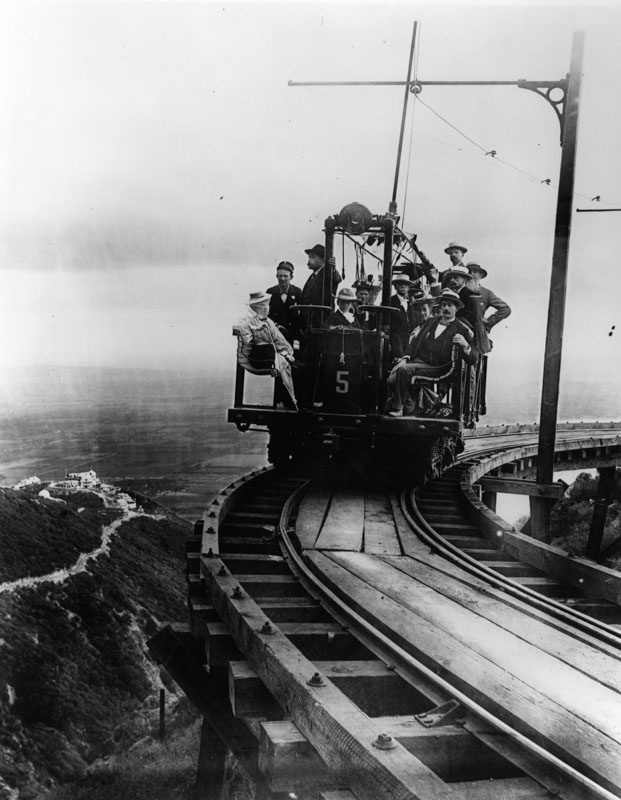 |
|
| (ca. 1894)* - A group of sightseers travels on one of the trolley cars on the Mount Lowe Railway as it rounds the area of track known as the Circular Bridge. Passengers can look out over the valley below. |
 |
|
| (1898)* - A Mount Lowe Railway car with passengers passes through a section of the track known as the Granite Gate. |
* * * * * |
Pacific Electric - New Ownership
 |
|
| (Early 1900s)* - A side view of an empty trolley car of the type used on the Mount Lowe Railway by the new owner, Pacific Electric Railway. |
Mt. Lowe Railway Changes Ownership For the seven years during which Thaddeus Lowe owned and operated the railway, it constantly ran into hard times. For one, its location was off the beaten path of the common traveler with little means of transportation up to the Altadena hillside. For another, fares did not cover the cost of continuous construction done on money borrowed at 10½% interest, and the opening day fare of $5.00 would not remain attractive to the greater public. Lowe went into receivership one or two times before losing the railway to Jared S. Torrance (founder of the city of Torrance) in 1899. The tiny railway was purchased at auction by a Mr. Valentine Payton of Danville, Illinois who, after only 14 months, sold it to Henry Huntington of the Pacific Electric Railway in 1902. Huntington operated it as a fringe venture the rest of its days alongside his expansive Red Car system that covered the greater Los Angeles and Orange County areas. Shortly after Henry Huntington of the Pacific Electric Railway acquired the Mt. Lowe Railway in 1902, he replaced the original open-aired trolleys with the ones as seen above. |
 |
|
| (1907)#^ – Postcard view showing the new Pacific Electric Railway trolley on the Alpine Division Section of the Mt. Lowe Railway. One could get some spectacular views of the city down below. |
 |
|
| (1907)* – Panoramic view of the valley below as seen from Mt. Lowe Railway. |
 |
|
| (1907)* - View of the Circular Bridge of Alpine Division of Mt. Lowe Railway and the valley below (Left Panel). |
 |
|
| (Early 1900s)^ - View of a trolley negotiating its way over the famous Circular Bridge on its way to the Ye Alpine Tavern. |
 |
|
| (1908)* - Close-up view of the Circular Bridge. Tourists would travel on this line between Echo Mountain and Mount Lowe. |
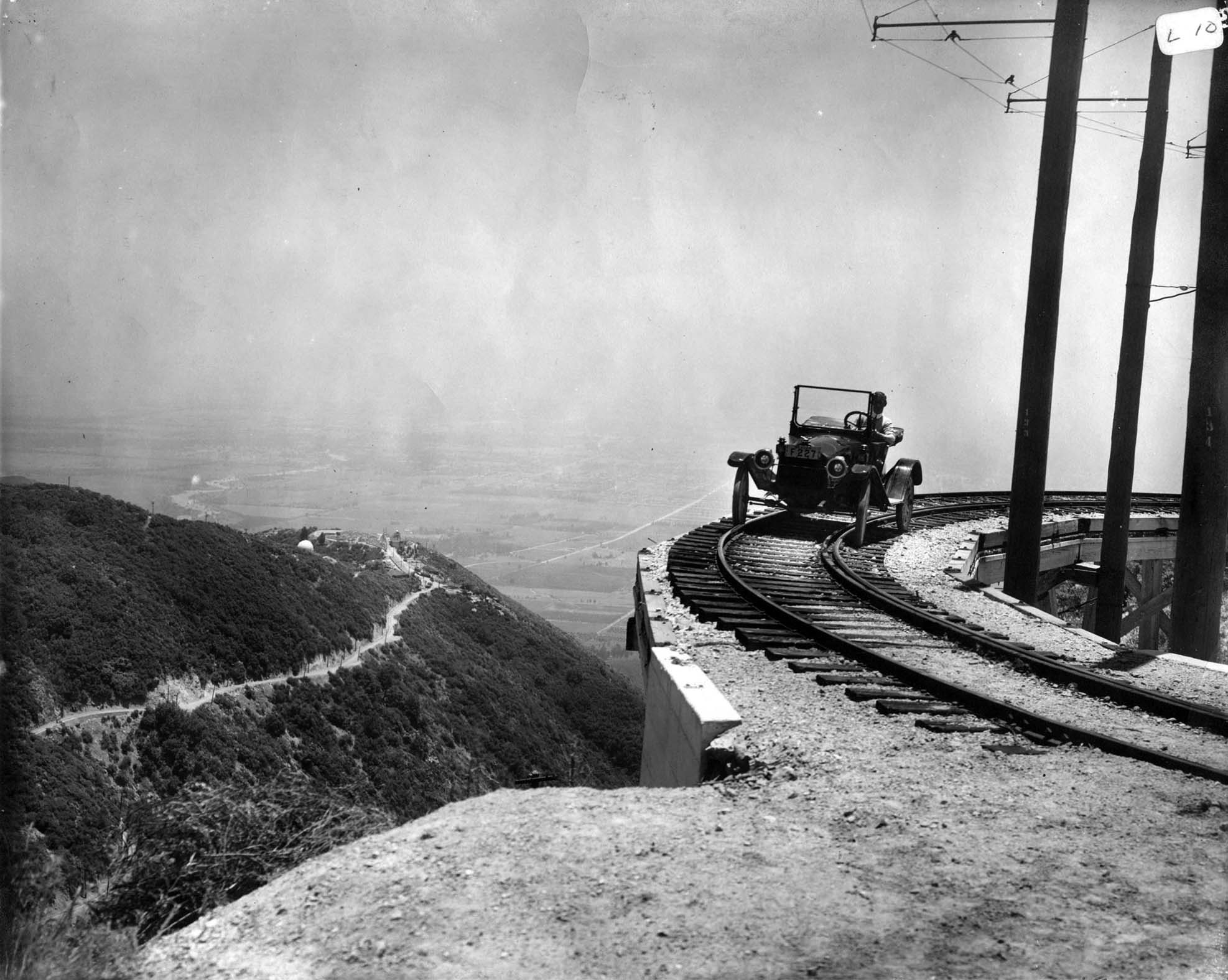 |
|
| (1914)* - A 1914 Metz Roadster poses for a publicity picture on Circular Bridge. Echo Mountain is at far left. The above photo was featured in the Pasadena Star (Sept. 10, 1914) where the headline read: “Five thousand is the number of autos: That many machines are owned in Pasadena and vicinity.” |
Historical Notes The automobile must have been taken up on the back of an incline car, as there were no auto roads in the vicinity at the time. A fire road reaches this spot today. |
 |
|
| (1915)* - A view of one the trolley cars on the Mount Lowe Railway (Pacific Electric Railway) as it rounds a curve on the Circular Bridge. |
 |
|
| (ca. 1915)* - Postcard view of Circular Bridge and beyond. |
 |
|
| (ca. 1915)* - Postcard view of Circular Bridge and beyond. Image enhancement and colorization by Richard Holoff. |
 |
|
| (1915)* - A trolley car on the Mount Lowe Railway travels through the section known as the Circular Bridge. |
 |
|
| (Early 1900s)* - A Pacific Rail car carries passenger to and from Mount Lowe. Note, another car is at the top of the hill rounding the Circular Bridge. |
 |
|
| (Early 1900s)* - A Pacific Electric Railway car travels through the San Gabriel Mountains on one of the sections leading to and from Mount Lowe called Granite Gap. |
 |
|
| (Early 1900s)* - A view of an open sided trolley car about to cross one of the many bridges on the Mount Lowe Railway line (Pacific Electric Railway). |
 |
|
| (ca.1915)* - View of outbound PE Alpine Division car No. 30 paused between Echo Mt. and Cape of Good Hope. |
 |
|
| (n.d.)* - Drawing of a panoramic view of Pasadena and it's surrounding cities as seen from Mount Wilson. Mount Lowe Railroad car crossing a bridge can be seen on the right side of the photo. |
 |
|
| (1907)* - A trolley car full of visitors rounds a snowy corner through the Alpine Division of the railway as it descends Mt. Lowe. |
 |
|
| (ca. 1927)* - A narrow-gauge trolley car rounds the corner at Granite Gate on its way down from Mt. Lowe Tavern after a snowstorm. |
 |
|
| (1927)* - Snowfall at Granite Gate (Elev. 4,700'), Mt. Lowe Rwy. Photo courtesy of Paul Ayers |
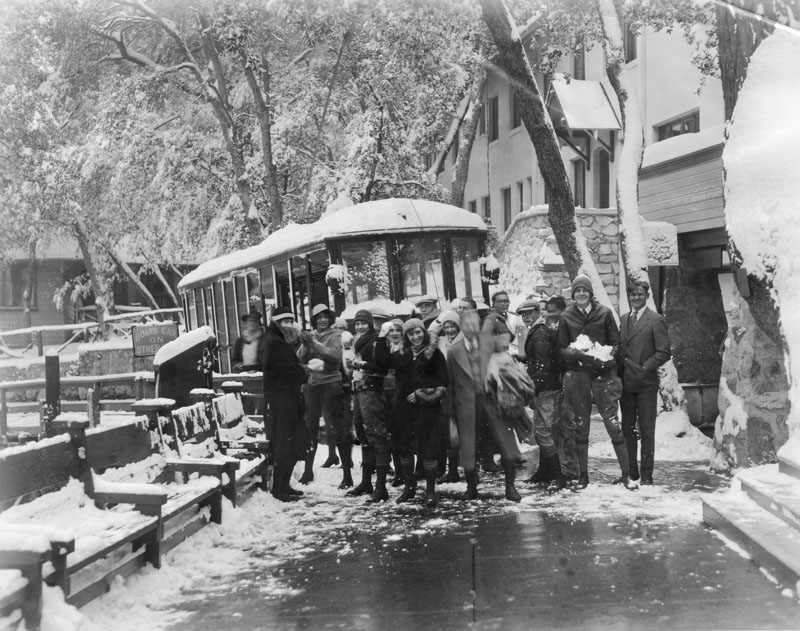 |
|
| (1930)* - Caption on the verso of the image reads, "Redondo High School students arrive at Mt. Lowe Tavern for a snow battle royal." |
* * * * * |
Ye Alpine Tavern (aka Mt. Lowe Tavern)
 |
|
| (1936)* - Exterior view of Ye Alpine Tavern showing a group of people lounging at the front of the tavern and a trolley car parked at the front. The tavern opened its doors on December 14, 1895, the same day that the Alpine Division of the Mount Lowe Railway began service. |
Historical Notes Ye Alpine Tavern was the end-of-the-line for the Mount Lowe Railway at the foot of Mount Lowe. It was renamed The Mount Lowe Tavern in 1925, and was burned down in September 1936. |
 |
|
| (ca. 1900)**^ – Panoramic view showing an early Alpine Tavern, prior to the Pacific Electric Railway purchase in 1902. Michael Patris Collection. |
Historical Notes Some of the signage is quite clear due to the quality of the image, including a sign for “Pony Trip to the Summit of Mount Lowe, with guide, time about two hours, tickets, $1.00, apply at hotel office.” The next sign reads, “Saddle Horses for Hire, Inquire at Hotel Office.” Note the porcelain “Long Distance Telephone” flange sign attached to the left fork of the tree, and the Mount Lowe Post Office sign behind on the larger tree, where is also states, “Alpine 5,000 Feet.” The two uniformed railway employees look on and just past the stairway to the entrance is “Ye Alpine Shoppe” where tourists and guests could purchase Mount Lowe souvenirs. The big log, buried in the ground at the end of the tracks, along with the heavy chain, was the terminus of the Alpine Division and where the trolley cars would be chained up to prevent any unwanted movement of the equipment. |
 |
|
| (ca. 1905)* - Page from a souvenir book of Pasadena scenes depicting the Alpine Tavern, Mt. Lowe Rwy., CA. Photo courtesy of Paul Ayers |
 |
|
| (ca. 1910)^* - View of the Ye Alpine Tavern, Mount Lowe. |
 |
|
| (ca. 1913)^^ - View showing two women and a man sitting on a bench next to another woman who is standing in front of a Pacific Electric Railway car. The Ye Alpine Tavern is seen in the background. |
 |
|
| (ca. 1913)^^ - View showing two women and a man sitting on a bench next to another woman who is standing in front of a Pacific Electric Railway car. The Ye Alpine Tavern is seen in the background. (Image enhancement and colorization by Richard Holoff) |
 |
|
| (Early 1900s)* - Group photo taken on the balcony of Ye Alpine Tavern, Mount Lowe. |
Historical Notes One of the only images of Thaddeus Lowe Jr.’s son, William Emmert Lowe as he stands in front of Alpine Tavern alone. Although he died in 1913 at a young age, his sister Florence made quite a name for herself, both literally and figuratively, as Pancho Barnes, who broke Amelia Earhart’s air speed record in 1930. |
 |
|
| (Early 1900s)* - Panoramic view of Ye Alpine Tavern, Mount Lowe. View shows front exterior of the tavern, scenery and some of the guests. |
 |
|
| (1895)* - Interior view of Ye Alpine Tavern showing a large lounge room with a fireplace, chairs and a piano on the right. |
Historical Notes The quote on the beam above the fireplace has been attributed to Thaddeus Lowe, but as it turns out Lowe borrowed it from Ralph Waldo Emerson. |
 |
|
| (ca. 1900)^# - Around the fireplace at Ye Alpine Tavern. |
 |
|
| (n.d.)* - Interior view of the large dining room at the Ye Alpine Tavern. |
 |
|
| (n.d.)* - Group of riders on mules, start their ascent on a trail that will lead them up to Mt. Lowe. |
Historical Notes Part of the charm around the Mt. Lowe sites was the grand display of nature and hiking trails, plus a mule ride that took guests around a trail referred to as the Mount Lowe Eight. The trail made a large figure eight traverse of Mt. Lowe and Mount Echo starting and ending at the Alpine Tavern without ever crossing the same terrain twice. |
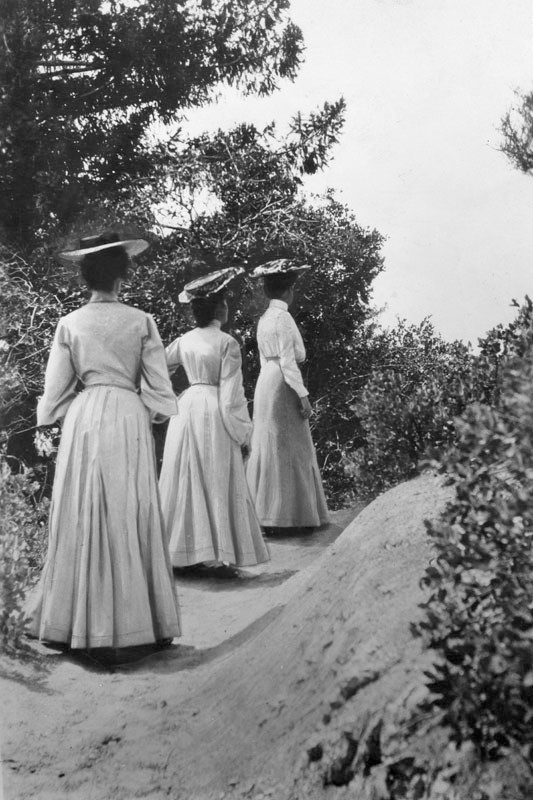 |
|
| (1902)* - Caption reads, "'Ah, there!' Behold, three young ladies of fashion determinedly, though circumspectly, hiking up the Mt. Lowe trail in the year 1902. Mountaineering was quite the thing in those halcyon times, but if anyone had so much as mentioned hiking outfits with 'shorts' to these gals, they probably would have hidden their blushes in the shrubbery." |
 |
|
| (1930s)* – A young man stands behind three directional signs at the Inspiration Pt. Rd. junction. Photo courtesy of Paul Ayers |
Historical Notes The man seen in the above photo is Leroy McVey who founded McVey Hardware in Temple City. |
* * * * * |
Inspiration Point
 |
|
| (1934)* – View looking down from the hill just above Inspiration Point looking east. This image shows the viewing tubes in front of the Ramada, Herbert the Mule and his OM&M Railway car, Easter Rock and the flag pole along the path between Herbert’s right-of-way and Easter Rock. Courtesy of Mt. Lowe Preservation Society |
Historical Notes Beyond Alpine Tavern, there were a number of activities to participate in, on top of Mount Lowe. Just a short walk from Alpine Tavern is Inspiration Point, which was completed in 1925. From there one could get some spectacular panorama views of the valley below. |
 |
|
| (1930s)* - A man looks through a viewing tube towards Venice while another man and woman look out toward the scenery below the mountain. |
Historical Notes Inspiration Point at an elevation of 5,080 feet, consists of a shade shelter with viewing tubes looking out to various Los Angeles landmarks and neighborhoods. |
 |
|
| (1934)* – Herbert the Mule readies for departure from Inspiration Point. Courtesy of Mt. Lowe Preservation Society |
Historical Notes In 1919, Ed Tobin built a cabin on the outskirts of Alpine Tavern, just past Inspiration Point. While hauling all those materials out to that point, Tobin realized that it would be easier to move the materials along a light rail line, and perhaps after the cabin materials had been moved he could haul passengers out to Morning Glory Point, overlooking Eaton Canyon. He could also charge a nominal fee, and thus create an income for himself. |
 |
|
| (ca. 1920s)* – View showing passengers on the One Man & a Mule Rwy. (OM&M) approximately 1/2 mile east of Inspiration Point. Photo courtesy of Paul Ayers |
Historical Notes Ed Tobin had the OM&M line in limited operation by early 1920s and a mule was put into service to operate the car. Common belief was that “Herbert” the mule pushed the car out along the right of way to prevent dust from being kicked up on the passengers. |
 |
|
| (ca. 1920s)* - Herbert the Mule pauses for passengers to get off the car and have a drink of water from the cooler at the right. Herbert might have even had a drink himself. Photo courtesy of Joe Tobin, son of Ed Tobin |
Historical Notes Ed Tobin kept a cabin in this area, where he lived for several years. When his son, Joe, was born, they moved to Alhambra, a suburb of Los Angeles. At that time Tobin sold the enterprise to a Swede named Ed Zetterwall. The OM&M Railway continued to operate until sometime in 1935, just before the demise of the Tavern and the Mount Lowe Incline Railway, in 1936. |
 |
|
| (Early 1900s)* - A collection of 5 promotional advertisements published by the Pacific Electric Railway between 1911 and 1927. Pacific Electric (owned by Henry E. Huntington) purchased Mount Lowe Railway around 1902. Note: The fare for a round trip ride was between $2 and $2.50, which was pretty steep in those days. |
 |
(ca. 1915)* - America’s Most Scenic Mountain Trolley Trip – Round Trip Fare: $2.50 from LOS ANGELES, $2.30 from PASADENA. | |
 |
|
| (ca. 1915)* - The Echo Mountain incline railway after Pacific Electric purchased it. Catalina Island can be seen in the distance. Click HERE to see more in Early Views of Catalina. |
Historical Notes Pacific Electric Railway rebuilt the cars used on the Great Cable Incline to include a roof on the top deck. These cars, stripped to their floors, were last used to carry salvage in 1938, when the Mt. Lowe line was scrapped. |
 |
|
| (ca. 1890s)* - Aerial view of Echo Mountain House overlooking Pasadena and the San Gabriel Valley. Note all the undeveloped land in the San Gabriel Valley below. |
 |
|
| (n.d.)* - Scenic view of clouds on Mount Lowe. Nature is beautiful, but at times so unpredictable. |
Historical Notes A series of natural disasters ate away at the facilities, the first of which was a kitchen fire that destroyed the Echo Mountain House in 1900. A 1905 fire destroyed the rest of the Echo buildings except for the observatory and the astronomer's cabin. In 1909 a flash flood tore out the Rubio Pavilion. In 1928 a gale force wind toppled the observatory. And in 1936 an electrical fire wiped out the Tavern. |
 |
|
| (ca. 1940)* - A view of one of the cable rail cars owned by Pacific Electric and used for trips to Mount Lowe. It is sitting on the storage tracks at the PE shops in Torrance, where retired cars were placed for salvage. Some sat there for years before being stripped and burned and some were recalled for WW2 service. |
Historical Notes The Mount Lowe Railway was officially abandoned in 1938 after a horrendous rain washed most everything off the mountain sides. Today, the ruins of Mount Lowe Railway remain as a monument to a once-ever experienced enterprise. It was placed on the National Register of Historical Places on January 6, 1993. |
 |
|
| (n.d.)* - Part of the trestle on the Pacific Electric Railway is damaged in a storm. This was a frequent occurrence over the years. |
 |
|
| (1947)*^* - Remnants of the Mount Lowe Railway Great Incline. Photo by Alan Weeks |
 |
|
| (1971)* - Shown here is a grip wheel, 9 feet in diameter, once part of the cable winding machinery located in the Echo Mountain cable house and used to pull the cable cars up and down the Incline portion of the railway. Today, 41 years after this photo was taken, one can pretty much see the same view at the top of Echo Mountain. |
 |
|
| (2022)* - Remnants of the Mt. Lowe Railway. Photo courtesy of Steven Nu |
 |
|
| (2010)* - Night view of the Los Angeles Basin from Inspiration Point, Mt. Lowe. Photo courtesy of Paul Ayers |
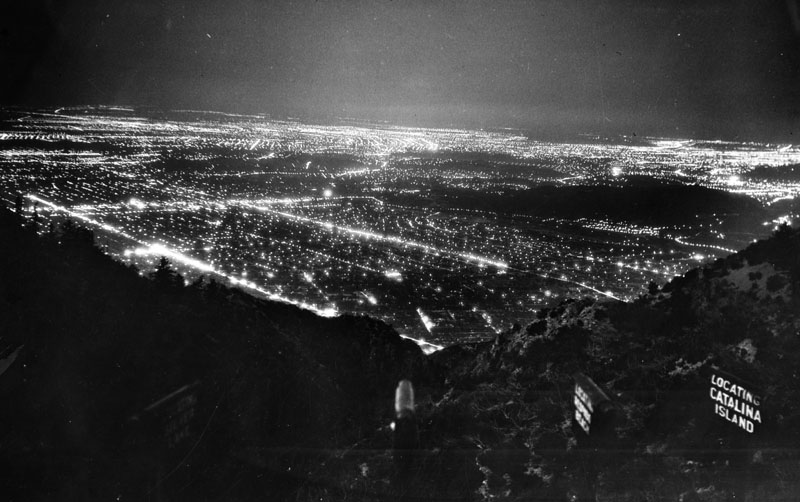 |
|
| (n.d.)* - Lights of Los Angeles and adjoining cities, as far distant as 60 miles, as seen from Inspiration Point, Mt. Lowe, 5,000 feet above the sea. Fifty-six cities may be viewed on clear nights from this vantage point, the thrill of which attracts thousands of visitors annually. |
 |
|
| (2015)* - View of illuminated hikers trekking up the Sam Merrill Trail to Echo Mountain for the 1st Annual Festival of Lights on 12-20-2015; taken from Sunset Ridge by Matthew McCawley. |
 |
|
| (Early 1900s)* - A young woman poses beside the Cable Incline section of the Pacific Electric Railway as the cable car named "Echo" is descending. Beyond lies a great view of the valley below and the mountains in the distance. |
* * * * * |
Please Support Our CauseWater and Power Associates, Inc. is a non-profit, public service organization dedicated to preserving historical records and photos. Your generosity allows us to continue to disseminate knowledge of the rich and diverse multicultural history of the greater Los Angeles area; to serve as a resource of historical information; and to assist in the preservation of the city's historic records.
|
More Historical Early Views
Newest Additions
Early LA Buildings and City Views
History of Water and Electricity in Los Angeles
* * * * * |
Further Reading
Scenic Mount Lowe Railway Historical Committee
Mount Lowe Preservation Society
Mount Lowe Railway Route Map (from Google)
Professor Thaddeus Sobieski Constantine Lowe
References and Credits
* LA Public Library Image Archive
^*Forum.SkyScraperpage: Cable-Car-Guy; Mt. Lowe Railway Profile; Ye Alpine Tavern; Inspiration Point
*^Wikipedia: History of Pasadena; Mt. Lowe Railway
^#Mt. Lowe Preservation Society
**UC Irvine - The White City by Miles Clement
*#Metro Transportation Library and Archive
+#Mt. Lowe Railway Construction
^^Pinterest: 1890's to 1920's Los Angeles
#*Huntington Digital Library Archive
#^Calisphere: University of California Image Archive
##California State Library Image Archive
*^*Pacific Electric Railway Historical Society
**^Facebook.com: Mt. Lowe Preservation Society
***Library of Congress: Panorama View from Mt. Lowe
< Back
Menu
- Home
- Mission
- Museum
- Major Efforts
- Recent Newsletters
- Historical Op Ed Pieces
- Board Officers and Directors
- Mulholland/McCarthy Service Awards
- Positions on Owens Valley and the City of Los Angeles Issues
- Legislative Positions on
Water Issues
- Legislative Positions on
Energy Issues
- Membership
- Contact Us
- Search Index